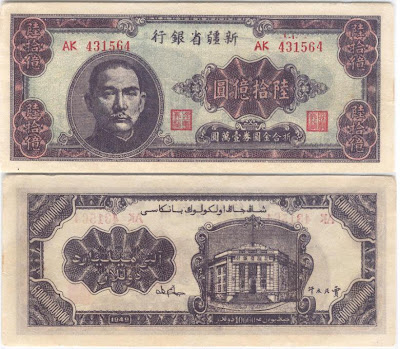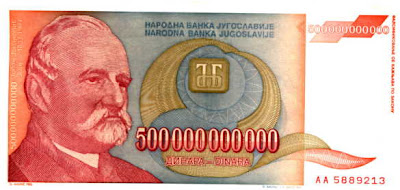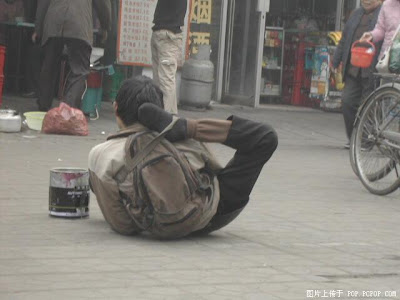Over at Opposite End of China, Michael has had a couple of posts about missionaries working in Xinjiang. Namely, that they keep getting kicked out, and he doesn’t find them to be very sociable. In my time in Xinjiang, I also found missionaries to range from distant (I got the impression I didn’t know the secret password/handshake) to outright batty. One character was a young man with Coke-bottle-bottom thick glasses who many of us ran into occasionally. He was always armed with a clipboard listing the gospel in Chinese and English and always seemed to be in a great hurry for an appointment. I once said hello to him after watching him ask a cigarette shopkeeper if she had heard the Word and she just ignored him. His side of the conversation consisted entirely of two topics: 1) his impending appointment and 2) had I heard the Word. Rumor has it he finally got an appointment with a provincial official, asked him if he heard the Word, and was sent back to the United States.
While missionaries in Xinjiang didn’t really bother me, I was kind of spooked by what I call the “Super Spies for Jesus” phenomenon. I don’t just mean the subterfuge of coming as English teachers because missionary activities are restricted. A great deal of missionaries who go to Xinjiang tend to be charismatic Pentecostals who subscribe to the concept of “strategic level spiritual warfare”, a concept I first read about over at No Fear of the Future.
While I’m no expert on the matter, I have been able to piece together some of the theory behind SLSW and the related idea of spiritual mapping. Note that alot of these sources tend to be from various Christian sects, since SLSW is a bit of a controversial topic – many Evangelicals seem to believe it more or less means incorporating the occult into Christianity. Its roots lie among the British charismatic revival of the 60 and 70s, according to Mennonite magazine Direction, while the Miller Avenue Baptist Church claims it started in 1989 with John Dawson’s book “Taking Our Cities for God: How to Break Spiritual Strongholds”. Dawson claimed that “satanic forces manifest themselves in the culture of the city”, and one must study the history and character of a city in order to cast out the demons that rule it and convert its inhabitants. Direction points out that in 1987, “Prior to the March [for Jesus, in London], a woman named Barbara Pymm reported being given a vision of two angels, swords raised and crossed over the city, “waiting for us to give the word to release them and their armies to fight against the principalities and powers over London.” The language of principalities, powers and strongholds come from bits of the New Testament, and SLSW interprets its somewhat literally – namely that there are spiritual battles between the forces of God and, well, other Gods.
One of the biggest proponents of SLSW has been C. Peter Wagner, of Global Harvest Ministries, who has written books such as Warfare Prayer and Breaking Strongholds in Your City. In Confronting the Powers, Wagner argues that spiritual warfare has been going on for centuries, and points to such major battles as St. John versus the Temple of Artemis, St. Benedict versus the Temple of Apollo, and St. Boniface versus the Tree of Thor (the Nordic guy with the hammer). In every case, some really strong praying essentially exorcises these demons – other peoples religions – from a place. In this Christian Science Monitor article, an example of a Nigerian preacher who goes after a local fortune teller:
Pondering the message of Eph.6:12 (“For we wrestle not against flesh and blood, but against principalities, against powers, against the rulers of the darkness of this world…”), they prayed to identify the source of Kiambu’s spiritual oppression, Mr. Muthee says. Their answer: the spirit of witchcraft.
Their research into the community revealed that a woman called “Mama Jane” ran a “divination clinic” frequented by the town’s most powerful people.
After months of prayer, Muthee held a crusade that “brought about 200 people to Christ.” Their church in the basement of a grocery store was dubbed “The Prayer Cave,” as members set up round-the-clock intercession. Mama Jane counterattacked, he says, but eventually “the demonic influence – the ‘principality’ over Kiambu – was broken,” and she left town.
The atmosphere changed dramatically: Bars closed, the crime rate dropped, people began to move to the area, and the economy took an upturn. The church now has 5,000 members, he says, and 400 members meet to pray daily at 6 a.m.
In some ways, spiritual warfare resembles (to a non-believer like myself, anyway) a sort of Dungeons and Dragons approach to the world. Some believers even mime putting on “God’s armor”, in another biblical reference taken rather literally, before engaging the enemy. There’s lots of swords and demons and, well, magic.
Wagner’s close associate, George Otis, ran with some of these ideas and came up with spiritual mapping. Spiritual mapping, for Otis, meant determining the location of “satanic command and control centers”, which are invisible and not to be confused with visible sacred sites, namely churches, mosques, synagogues, etc. At least, so says this blog on heresies run by Discernment Ministries (they consider spiritual warfare heretical). An interesting point the blog does bring up is that spiritual mapping focuses on ethnicity and “unreached peoples”. Indeed, a major project along these lines is the Joshua Project, a sort of CIA World Factbook for Pentecostals, which lists the “Unreached Ethnic Peoples” of the world with colorful maps and statistics. Wagner has more recently espoused the idea of identificational repentance and corporate sin. In other words, Wagner argues that people should repent “national sins”:
Identify the national sin. This is no place for vagueness. We must be specific, not evasive. For example, the principal sin of my nation, the United States, is clearly racism and our corporate sins which have established the spiritual strongholds are clear. The broadest and most pervasive sin that our nation ever committed was bringing Africans to our shores as slaves human merchandise to be bought, sold and used for any conceivable purpose to satisfy the desires of their white masters. But beyond this, the deepest root of national iniquity, and also, as I see it, one of the primary causes of our subsequent lust for slaves, was the horrendous way we white Americans treated our hosts, the American Indians. What does the breaking of over 350 solemn treaties say about U.S. national integrity?
The writer behind this new doctrine? John Dawson again. Wagner’s example doesn’t mention what this means for new converts in the “40/70 Window”, which is the name for the area of the Eastern hemisphere between 40 degrees and 70 degrees north of the equator, or Europe and everything above, say, Pakistan and Iran, slicing nicely between Xinjiang and Tibet. Previously the campaign was the “10/40 Window“, which focused more on India and Africa. Another example of identificational repentance is this one, when a Chinese convert confessed the corporate sin of the People’s Republic of China invading India in 1962 to Punjabi attendees.
Brother Peter Xu initiated an act of identificational repentance on behalf of his homeland China. It was directed to the many Indian delegates that were in attendance. Historically, the 1962 China—India Border War, which began 43 years prior to the week of the Asian Summit (October 10–14), was a dark spot on the relations between these ancient civilizations. This public repentance was a deeply emotional time as delegates from Taiwan and Hong Kong joined in solidarity with these Chinese leaders to humbly cry out to our Heavenly Father for mercy and forgiveness on behalf of their motherland.
The Christian Science Monitor also reported of the Windows and Joshua projects back in 1999, giving us some idea of the number of participants (allegedly):
Praying Through the Window began in October 1993, when some 21 million (according to AD 2000) prayed for the 62 nations in the window, and 188 prayer-journey teams took 257 journeys to pray on site, visiting each of those nations. During October 1995, some 36 million followed a prayer calendar targeting 100 “gateway cities” in the region, along with more prayer journeys. And in October 1997, prayers focused on the 1,739 unreached-people groups. The final effort is planned for October, targeting 3,000 “strategic towns.”
To support this and “Joshua 2000” – the church-planting project – research and mapping organizations have created databases, people profiles, and maps to give intercessors tools to make prayers specific.
The developer of the Joshua Project, Ralph Winter, was involved with both the Fuller School of World Missions and the AD2000 project, both of which were founded by C. Peter Wagner. Wagner himself is heavily involved with the Lausanne Movement, started by Billy Graham, and was doing many co-projects with Ted Haggard, of gay sex and Jesus Camp fame. And the language of SLSW is used elsewhere as well:
Q. I live in an area where drugs, alcoholism, immoral behavior and despair are a way of life. Since moving here, I’ve begun drinking and lying to the woman I love. My business and personal life have declined. Do you believe there are areas under demonic strongholds? What can we do? Should we move away?
Pat Robertson: You ought to move as fast as you can. Yes, there are demonic strongholds, without question. There is no doubt about it. There are certain areas where demon princes hold sway. And this thing has obviously got hold of you. Get away from there as fast as you can. Confess and recommit to the Lord. Absolutely. But get away from there. Flee.
The AD2000 movement, Global Harvest and the Lausanne Movement all involve an interchangeable cast of characters. Global Harvest and C. Peter Wagner, however, emphasize the 40/70 Window and, curiously, Xinjiang. Under the auspices of the Strategic Prayer Network, which Haggard was involved in, Wagner went to Germany for “Target Germany” in 2001. At Target Germany, Wagner introduced Pastor Kim Sam Seeong (google cache of DOC file) outlining their Silk Road strategy:
“He is one of the two major apostles of the 40/70 Window. Roger Mitchell is the apostle of Target Europe. Kim Sam Seong is the apostle of Target Silk Road.”
Kim then said:
Obstacles of the gospel in the Silk Road are about worship. Do we have true worship or false worship? Through history in every territory over this Silk Road area, every kind of idol worship, curse, and power came in and spread out. From the West came humanism to this territory, Hellenistic Humanism. From the East the Babylonian worship system and also the Indian worship system with all kinds of things mixed in. It is very difficult to identify what is stronger and what is weaker. Nowadays, we can identify the strongest one, two, or three. The first is the spirit of Moon Goddess or Islam. Because the Silk Road area is Turkic, most of them speak Turkish. They understand each other. Some of them speak the Tajik language but for the most part they speak Turkish. This is a time to raise up the Turkic people. Turkic is the key Hindi people [sp]. From the Silk Road we can evangelize all of the world. If we can identify the spirits in the Turkic people, we can destroy Satan’s wells… The Chinese government has a ten year project to develop northwest China, the Xinjiang Province which belongs to the Turkic language group. It is the only Muslim area in China. God is preparing the way to go out through the Silk Road area. The border will be open very wide through the economy. They are going out right now.
So let’s get this straight: the adherents of Strategic Level Spiritual Warfare see a strategic, uh, harmony, with the PRC’s Western Development Strategy.
In 2000, as the 40/70 Window campaign started to warm up, Wagner said:
Wagner: The greatest challenge facing the global mission movement in the coming decade is to evangelize the 40/70 Window, the only major region of the world, with the exception of the Arab Muslim bloc, where the movement of God is virtually at a standstill. The two major segments of the 40/70 Window are post-Christian Europe and the Silk Road/Turkic Belt. As examples, there are proportionately fewer born-again Christians in Poland than in Nepal. There are proportionately fewer born-again Christians in Spain than in Japan. And I believe that the significant breakthrough that we have been praying for in the entire Muslim world, including the Middle East, will begin among non-Arab Muslims from Turkey to the Xinjiang Province of China.
Probably my favorite example of spiritual warfare in Xinjiang is from this 1993 newsletter from Revival Chinese Ministries International, a Pentecostal outfit in Hong Kong. A gospel reading team in Xinjiang kept getting beaten up, perhaps because they were doing this:
According to the leader of this dare-to-die gospel team, team members had been conducting prayers of spiritual warfare outside the mosques for some years now. Of late, the team has sensed a change in the spiritual atmosphere there.
The Lausanne Movement has a long, long article on the intricacies of spiritual warfare that I can’t be bothered to read by Paul Hiebert, another advocate of these theories. More interesting is the Lausanne Movement’s Chinese case study which is supposedly by one “Luke Shao”, who spent ten years studying Qi Gong, only to realize after he became Christian that he had been in contact with a demonic power:
From Luke’s ten year experience in qigong, he divided the practice of qigong into three stages. The first stage is physical exercise through a method of breaking so as to move the “air” (qi) into the interior parts of the body for health reasons. The second state is when one desires to have supernatural power, such as the ability to heal illness or extr-sensory perception. That supernatural ability, according to Luke, comes from demonic spirits. The third stage is when one becomes so bound to various demonic spirits that he become totally enslaved by these spirits. During this last stage, one can even experience one’s spirit leaving one’s body to hover around.
Remember, these are not the doctrines of some whacked out fringe. These are movements connected to most of the major leaders of the Evangelical communities, and they preach what more or less seems to amount to a form of religious imperialism. While they deserve the right to practice their beliefs openly, I find nothing innocent or sweet about them. At least the Jesuits brought their science gear.
 Some child beggars are intentionally crippled by pimps to elicit sympathy [photo from PCPop]
Some child beggars are intentionally crippled by pimps to elicit sympathy [photo from PCPop]





